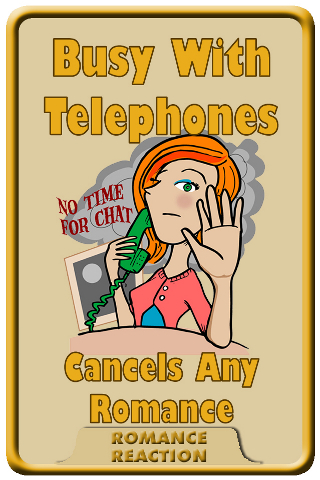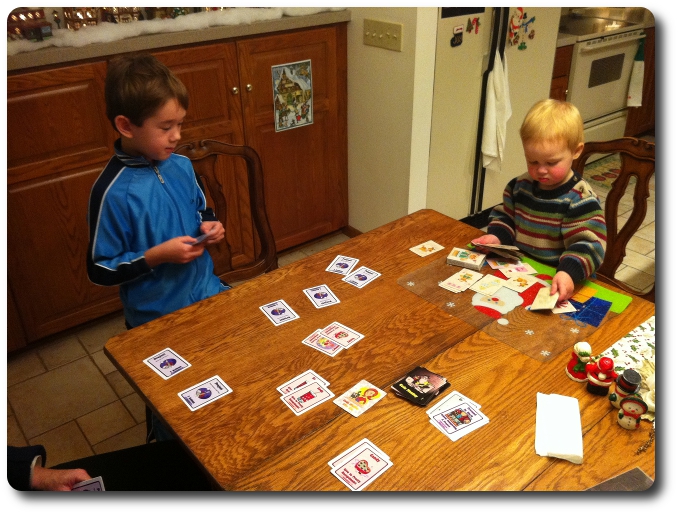 The Basics:
The Basics:
- For ages 7 and up
- For 2 to 5 players
- About 15 minutes to complete
Geek Skills:
- Counting & Math
- Reading
- Logical & Critical Decision Making
- Strategy & Tactics
- Hand/Resource Management
Learning Curve:
- Child – Easy
- Adult – Easy
Theme & Narrative:
- Balancing life and work can be difficult, especially when all the work continues to pile up on your desk!
Endorsements:
- Gamer Geek rejected!
- Parent Geek approved!
- Child Geek approved!
Overview
Welcome to the wonderful world of corporate entry-level programming! Expect to be given more work than you can handle, be told how to do your job, and have your fellow programmers attempt to one-up you constantly. It’s not all bad. You have an endless supply of snacks and, best of all, the pretty receptionist that works down the hall might know your name! Just another day at the office, but this time, you are going to leave feeling a winner…maybe.
For those readers who do not know what a “code monkey” is, it’s a term used to describe an individual who writes computer programs. They might prefer to be called “software engineers”, but code monkey has a much more interesting ring to it.
Code Money is a card game comprised of 54 cards. Within the deck are “Pretty Receptionist”, “Project”, “Completion Reaction”, “Romance”, “Romance Reaction”, “Energy Snack”, “Special Reaction”, and “Special” cards. More on all these shortly. The cards are printed on firm cardstock and the colors and artwork are bright, vibrant, and whimsical. Throughout the game components, the game theme is further reinforced and supported with a solid art direction and clear eye for detail.
Game Set Up
Go through the deck of cards and remove the “Pretty Receptionist” card. This card is easy to find as it is has the same art on the front and back. Shuffle the remaining cards and deal each player 5 cards, face-down. The rest of the deck goes in the middle of the playing area. Place the “Pretty Receptionist” card next to the deck.
Space-wise, each player will need to have enough room in front of them to play Project cards and Romance cards. There also needs to be enough room in the playing area to place the “Pretty Receptionist” in front of the current player who has her favor.
That’s it for set up! Let’s play!
About the Cards
Code Monkey uses cards to play actions and reactions to actions. Every card has a purpose in the game, but when they are played is up to the player. The card types are as follows:
Pretty Receptionist
This card represent’s one of the two objectives that must be met to win the game. The pretty receptionist’s attention will be fought over by the players but not in a sinister or violent way. Romantic gifts will be the player’s ammo used in this war of attention-getting.
Project Cards
These cards represent one of the two objectives that must be met to win the game. Projects are played out in front of the player in attempts of completing them. Time (in game actions) is necessary and some projects take longer than others to complete, but you can also get a boost by using other cards to complete projects quickly.
Completion Reaction Cards
These cards cause completed Projects to suddenly, well, not be so complete. These are reaction cards played when another player announced a completed Project.
Romance Cards
Flowers, candy, and other tokens of affection can be given to the Pretty Receptionist to break the ice and win her favor; however, the Pretty Receptionist is a classy gal and will not necessarily always want the same gift twice and will sometimes politely decline gifts from players.
Romance Reaction Cards
Even the most well intentioned and thoughtful gift can horribly backfire. These cards cause Romance cards to be rejected when they are offered.

Example of Romance Reaction card
Energy Snack Cards
The days can get very, very long in the office! A quick energy boost can cause an employee’s productivity to jump 110% and then some! These cards allow players to complete Projects quickly.
Special Cards
These cards provide special actions that the other cards do not.
Special Reaction Cards
These cards cancel “cancel” cards and nothing else.
Playing the Game
On a player’s turn, actions are taken first and then the player draws cards to restock their hand. The player can take any of the following actions, twice.
- Play a Project card in front of any player, but no more than two uncompleted projects can be out in front of a player at a time
- Play a Project card with an Energy Snack card to automatically complete it
- Play an Energy Snack card on an existing Project card to complete it
- Play a Romance card (see “The Rules of Office Romance”)
- Play a Special Card
- Discard cards (one or all cards, but you don’t draw new cards until after your two actions)
- Pass (do nothing)
After the player takes two actions, they then draw their hand back up to five cards. Play continues with the player to the left.
Getting IT Done!
Projects will normally take 1 or 2 actions to complete. All Projects will remain “unfinished” until the player spends 1 or 2 actions to complete them. To complete a Project, the player need only state they are spending the actions necessary to complete it or play an Energy Snack or Special card to the discard pile. Note that Projects will not complete themselves if they are just left in front of the player (sadly). For example, a Project that takes 1 actions to complete will not magically be completed next turn. This is important as a player cannot win if they have any uncompleted Projects in front of them.
When a project is completed, it remains in front of the player and is turned 90 degrees to signify it is no longer an uncompleted project. Completed projects do not count towards the player’s two uncompleted project limit.
The Rules of Office Romance
Players can attempt to attract the attention of the Pretty Receptionist during their turn by offering gifts. These gifts are offered using the Romance cards. These cards are played out in front of the player for all to see (it must be a very small work environment). Once the player has more Romance cards than any other player, the Pretty Reception card is placed in front of that player signifying that they currently have the Pretty Receptionist’s favor.
Players can continue to offer gifts to the Pretty Receptionist to make it difficult for other players to steal her attention away. However, the player cannot play Romance cards that match other Romance cards already in play. This rule only applies to the player who currently has the Pretty Receptionist in front of them. For example, a player could not play another “flowers” card to their Romance pile if the Pretty Receptions is in front of them and there is already a “flowers” card in the existing Romance pile.
Note that other players can block your office romance shenanigans by playing Romance Reaction cards that cancel the Romance card, sending the player’s gift to the discard pile. They can also outdo the other players by offering more Romance cards then anyone else, shifting the Pretty Receptionist’s attention to them.
Interruptions and Disruptions
At any time during the game, a player can discard a Romance Reaction card to cancel another player’s Romance card, but only on a Romance card about to be played. These do not count as a player’s action. For example, you could cancel an opponent’s attempt to offer flowers to the Pretty Receptionist, but could not cancel flowers already given.
Players can play, as an action, a Completion Reaction card to cause an opponent’s previously completed Project to now be an uncompleted project.
There are exceptions, of course, like the ability to cancel an opponent’s already completed project, and players do have the ability to cancel a cancel.
Winning the Game
The game ends as soon as a player completes the following:
- has completed 2 Projects
- has no uncompleted Projects
- has the Pretty Receptionist’s favor
Once the victory conditions are met, that player is crowned the winner!
To learn more about the game and read the complete rules, see the game’s official web site.
Prediction
While I have no doubt the romance portion of the game will go right over the heads of my little geeks, they are adept enough in games to understand how to play and win Code Monkey. My 7-year-old should have no problem playing the reaction cards as he has played other games with the instant action/reaction game mechanic in the past and has done very well with it. My 4-year-old is working on it, but is not as advanced as his older brother. Not surprising considering the age and experience difference, but enough of a gap to warrant concern and special note.
Explaining Code Monkey to my little geeks didn’t take long. The game is not overly complex and the actions are very straight forward. The only part that threw them a bit was playing the Energy Snack cards to complete a project right away. They kept asking me how it was possible to not spend an additional action by doing so. Their questions were valid and all I could do is tell them “it was in the rules”. That was good enough for my 4-year-old, but my 7-year-old didn’t seem to accept my answer as final. In the end, we agreed to simply disagree and just follow what the rules said.
After a few rounds of practice play and answering any other additional questions, I shuffled the deck and asked them their thoughts on the game so far.
“Looks easy enough. Still not sure about the Energy Snack not being an action, but if you say it’s OK, I’m fine with it.” ~ Liam (age 7)
“You’re a code monkey, Daddy!” ~ Nyhus (age 4)
I’m not hearing anything terribly negative nor am I hearing much excitement. Might be the game or just the way my little geeks are feeling at the moment. Let’s play and find out!
Final Word
My 4-year-old has set the new land speed record for quickest game started and then quit. He was dealt his cards, smiled at me, and then said he was going to go play with his Bionacles. Clearly, Code Monkey was not for him. My oldest little geek and mom stuck around and we had ourselves a game.
Our first game was pretty “blah”. I was able to complete two projects and win the heart of the Pretty Receptionist quickly and won the game. My mom and little geek just blinked at me when I said the game was over. They demanded a rematch.
Our second game was a bit tighter. My oldest little geeks focused on getting his projects done, as did my mom. But whenever they did, I just put one more project in front of them. This kept them bogged down and I was able to again win the game. The reaction from the table was not pleasant. Clearly, I had somehow upset both my little geek and my mom.
Our third game was a lot of fun and very close. My little geek had learned how to play and play well after being beaten twice and watching what I was doing. My mom also stepped it up and was exceedingly aggressive in her method of play. This made the game exciting and close. We were making so much noise at the table that my 2-year-old decided to join us. He didn’t play, mind you, but he did want to be where the action was. I am most pleased to say that I did not win the game and the victory went to my mom.
Our fourth and final game was another nail bitter as all the players worked fast and hard, blocking with reaction cards when they could, stealing the Pretty Receptionist’s attention, and offloading work to their opponents. The game went to my little geek who won with a lucky draw of one of the few Romance cards left. In the end, we all agree the game was much fun.
If you are wondering where the inspiration of the game came from, give the song Code Monkey by Jonathan Coulton a listen. Before you let your little geeks listen to it, be aware there is a little bit of “colorful language” in the lyrics.

Game four and everyone is playing strong - including my 2-year-old who is playing his own game with a deck of cards
Gamer Geeks, this is a fun and easy game, but lacks the teeth to be a “gamer’s” game. Most certainly an excellent filler, but does not come close as the “main event” for your next gaming group. Do give it a try, however, and you’ll enjoy the tongue-and-cheekiness of the theme and perhaps even relate a bit too much to it.
Parent Geeks, this is a mixed bag of a game. The game itself is solid and a lot of fun to play with the family. For this reason, I gave it an “approved” endorsement for the Parent Geek crowd. The theme, however, might give you slight pause. The Romance card just might make you turn up your nose to the game, but I encourage you to give it a go. There is nothing sexual or underhanded in the way the Romance cards are played or used. If it helps and you think it is necessary, tell your little geeks the player who gives the most gifts gets the Pretty Receptionist as their friend. This worked very well for us and we avoided the whole romance theme altogether without reducing the level of fun.
Child Geeks, this is a fast game that will teach you three things. First, it is very important to get your work done, but always be ready for more work to fall in your lap. Second, friendship is worth pursuing and will help you succeed. Third, being a programmer might not be what you want to do with your life, career-wise. Expect to play hard and fast to keep the lead and laugh as your opponent’s groan when you dump more work on their desk!
I personally found Code Monkey to be silly and easy, which was exactly what I was hoping for. The game’s theme is played out well through the narrative driven by the card play. The game mechanics itself are solid, quick to teach and to play. The rules could use some work, specifically detailing when a reaction card can or cannot be used, for example. Other than that, Code Monkey is great, entertaining, and humorous. Give it a look and see if the game is right for you.
This game was given to Father Geek as a review copy. Father Geek was not paid, bribed, wined, dined, or threatened in vain hopes of influencing this review. Such is the statuesque and legendary integrity of Father Geek.




Nice write-up! Excellent how you were able to rate the game for different age groups and different levels of gamers, from casual to geeks!
Pingback: Re: Your Brains Game Review » Father Geek